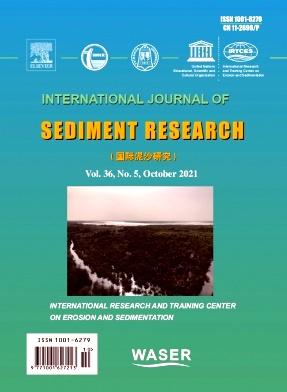Impact of the solid volume fraction of clay and consolidation on the erodibility of sand-mud mixtures
IF 3.7
2区 环境科学与生态学
Q2 ENVIRONMENTAL SCIENCES
引用次数: 0
Abstract
The erodibility of sediment mixtures is a key factor in sediment dynamic processes and morphological evolution in coastal environments. However, it remains insufficiently understood. In the current study, the critical shear stress of sediments is analyzed with different mud contents and consolidation degrees from experimental results and previous studies. The results indicate that the critical shear stress increases with clay content, peaking at 30% clay content, and then gradually decreasing. Compared to the solid volume fraction of mud (clay and silt), the solid volume fraction of clay shows a higher relation with the critical shear stress of sand-mud mixtures. The role of the consolidation degree in the erodibility of sediment mixtures was quantified through consolidation experiments, revealing an exponential relation between critical shear stress and consolidation coefficient. An empirical equation for the critical shear stress is proposed to consider the mud content, the solid volume fraction of clay, and the consolidation degree. This equation is applicable to mixed sediment over the full range of mud content and varying consolidation degrees. It has a simple form, is easier to apply, and outperforms other empirical equations (RMSE = 0.62; R2 = 0.73).
粘土固体体积分数和固结对砂泥混合物可蚀性的影响
泥沙混合物的可蚀性是影响海岸环境泥沙动力过程和形态演化的关键因素。然而,人们对它的理解仍然不够充分。本研究结合实验结果和前人研究,分析了不同泥质含量和固结程度下沉积物的临界剪应力。结果表明:随着粘土含量的增加,临界剪应力逐渐增大,在粘土含量为30%时达到峰值,随后逐渐减小;与泥浆(粘土和粉砂)的固体体积分数相比,粘土的固体体积分数与砂泥混合物的临界剪应力的关系更高。通过固结试验量化了固结程度对混合泥沙可蚀性的影响,揭示了临界剪应力与固结系数之间的指数关系。提出了考虑泥浆含量、粘土固体体积分数和固结程度的临界剪应力经验方程。该方程适用于全泥含量范围内不同固结程度的混合泥沙。它有一个简单的形式,更容易应用,并优于其他经验方程(RMSE = 0.62; R2 = 0.73)。
本文章由计算机程序翻译,如有差异,请以英文原文为准。
求助全文
约1分钟内获得全文
求助全文
来源期刊
CiteScore
6.90
自引率
5.60%
发文量
88
审稿时长
74 days
期刊介绍:
International Journal of Sediment Research, the Official Journal of The International Research and Training Center on Erosion and Sedimentation and The World Association for Sedimentation and Erosion Research, publishes scientific and technical papers on all aspects of erosion and sedimentation interpreted in its widest sense.
The subject matter is to include not only the mechanics of sediment transport and fluvial processes, but also what is related to geography, geomorphology, soil erosion, watershed management, sedimentology, environmental and ecological impacts of sedimentation, social and economical effects of sedimentation and its assessment, etc. Special attention is paid to engineering problems related to sedimentation and erosion.

 求助内容:
求助内容: 应助结果提醒方式:
应助结果提醒方式:


